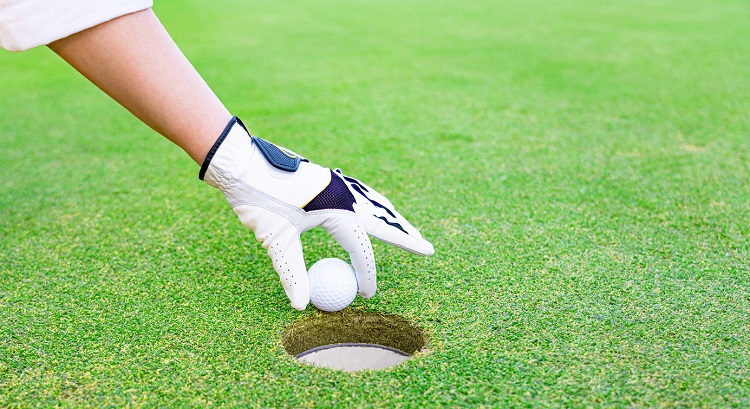In 1990, the USGA and R&A came together and set the diameter and weight of the golf ball that we all play with today. With a minimum ounce weight of 1.62 and an inch diameter of 1.68, the golf ball has remained the same for over 30 years.
Equipment manufacturers have set this golf ball size as universal regardless of what type of measurement system.
But how did we get here in golf history?
The first golf balls used feathers, tree sap, and wood, while more modern balls use compounds like Surlyn and rubber wound cores.
Older golf balls, known as a British ball, can still be found with a diameter less than 1.68 inches, as some golf balls, pre-1990s, had a width of 1.62 inches.
In this history of golf ball size, we’ll take a look at how far the golf ball has come over several centuries into the modern ball we all know and enjoy every time we hit the course.

Golf Ball Size History (British Ball & American Ball)
British Golf Ball
In the earliest days of golf in England and Scotland, players used hard wooden golf balls to play the course. With the hard nature of the ball, golfers switched over to the featherie in the 18th century.
This new golf ball, made with a leather exterior and feather interior, was softer than the previous golf ball, but incredibly expensive to create.
The featherie was also often misshapen, with a regular difference in diameter, and not perfectly round, making the ball flight incredibly unpredictable.
Next, players from the two countries moved onto the “guttie” from the featherie in the mid-19th century.
The new ball used the dry sap of the Malaysian sapodilla tree. It was easy to produce, could be reformed when damaged, and was less expensive that the feathery.
American Golf Ball
After the guttie became the norm in England, Coburn Haskell of Cleveland, Ohio, disrupted the entire golf ball market with his golf ball creation.
While it began to take the form of today’s golf ball, the new model used rubber thread to form a core around a rubber ball center.
The ball was covered with a shell of balata sap, from the balata tree, native to Central and South America. The balata exterior was soft, created back spin, and had the dimples necessary to produce predictable flight.
The velocity of this new American golf ball generated most distance than ever from a golf ball.
Later, the balata golf ball would give way to a new synthetic golf ball made from Surlyn. This compound was found to be more durable than the balata ball, creating a durability difference that made the new ball preferable to weekend warriors everywhere.
Difference Between the British and American Golf Ball
The American ball, by USGA (United States Golf Association) Rules, must reach a diameter of 1.680 inches and not exceed 1.620 ounces, or 45.93 grams.
Until the 1990s, the British governing body, the R&A, allowed the standard use of golf balls less than a diameter of 1.68 inches. These smaller golf balls were nicknamed as the “British ball” by professional and amateur golfers.

Standard Golf Ball Size
Compared to mini golf with a ball size of between 37 and 43 mm, a USGA-legal golf ball must reach a diameter of 1.68 inches or 42.67 mm, and a maximum ounce weight of 1.62 oz. or 45.93 grams.
These standards have been approved by the USGA for America and by the British R&A, that governs golf around Scotland and England.
Any golf ball found to be heavier or larger than this diameter or weight is considered illegal by the USGA rules and golfers playing these golf balls will be disqualified from open tournament competitions.
A golf ball does not have a standard when it comes to the number of dimples on the surface, as manufacturers can implement technology to create as many dimples as they want, although the small size of the golf ball prevents more than around 500 at most.

Current Rules on Golf Ball Size
Size
According to the USGA rules of golf, the ball can have a maximum diameter of 1.68 inches, or 42.67 mm. With the hole’s size of 4.25 inches, the ball is about 2.5 times the width of the cup.
Golfers play with this size because when coupled with the USGA weight standards, the combination provides the ideal weight and diameter for maximum distance.
Before 1990, the ball was smaller with a measurement of 1.62 inches from side to side.
Weight
The weight of a golf ball according to the USGA rules of golf cannot drop below a minimum of 45.93 grams or be larger than 1.62 ounces.
These standards are uniform across all professional competitions, including open championships so all golfers play with the same minimum measurements for the ball.
Previously, smaller golf balls created an issue with less distance, so rather than keep them small, manufacturers encouraged bodies like the USGA to make uniform measurements.

Differences Between a 2 Piece, 3 Piece, and Multi-Layer Golf Ball
2-Piece Golf Ball
2-piece golf balls are 42.67 mm in weight and 1.68 inches in diameter. They consist of an outer layer, known as a cover, and a smaller interior consisting of one solid core made from a plastic compound.
These 2-piece golf balls offer more distance because they are harder at the center for better compression for slower swingers.
3-Piece Golf Ball
3-piece golf balls offer the same 1.68 in and 42.67 mm width and the same open weight at a max of 1.62 ounces as USGA standards. These balls have three parts; the cover, the small inner core, and a third piece that goes around the small inner core.
With a weight of 45.93 grams, these balls are crafted to weigh within the specifications of all governing bodies in the sport.
Multi-Layer Golf Ball
A multi-layer ball offers more sophistication because it offers softness, shot-shaping, and exceptional distance. Adhering to the minimum rules on size and weight, these golf balls offer the same diameter, 1.68 in. or 42.67 mm and heft, 45.93 grams or 1.62 oz.
The ball has several smaller inner layers that surround a smaller core. With a weight of 45.93 grams, the interior material must be matched to specifications to become legal, forcing designers to get creative with the multi-layer balls.
Question and Answers
Do all golf balls have the same size?
Yes, in today’s golf market the size of a golf ball has a universal standard that must reach 1.68 inches, or 42.67 mm, in diameter. The weight of the golf ball according to USGA rules is no more than 1.62 ounces, or 45.93 grams.
This weight and height of golf balls is ideal for golfers as it provides the most ball velocity and distance possible, along with a moderately high spin rate.
Additionally, the diameter of modern golf balls work well with the size of the cup on open courses at 4.25 inches.
When did the golf ball change size?
The golf ball has changed sizes multiple times over the centuries, but the standard of 1.68 in. and no more than 1.620 oz., was made as the playing minimum measurements in 1990.
The British R&A wanted the British ball to stay at 1.62 inches in diameter for their own rules of golf.
But with the game increasing in popularity in America, the size became universal after a compromise with the USGA and British golf governing body.
Manufacturers soon adopted the technology to create these golf balls to this size for the open market, so amateurs could play with the same ball as the pros.
What is the size of a golf ball in centimeters?
The golf ball size in centimeters is 4.268 cm or 42.67 mm in diameter. For playing equipment, this standard is equivalent to 1.680 inches, as every golf ball must meet that minimum to be legal to play in tournaments.
The size of these golf balls, as approved by the rules of golf authored by the United States Golf Association, or USGA, is uniform because this specific weight and diameter provides the best velocity and distance for all playing conditions.
Why is a golf hole 4.25 inches?
In 1891, the British R&A rules governing body established the 4.25-inch diameter for a golf hole. Before installing these regulations, the size of the hole was larger, up to six inches in depth in some instances.
There have been conversations of widening the hole for weekend warriors to make it a more enjoyable game. Professional golfers like Jack Nicklaus have expanded the holes to eight inches for his open member tournaments at his Muirfield Village Golf Club.
Most agree, however, that the standard diameter of 4.25 inches will not be adjusted for professional golf by either the USGA or British R&A.
